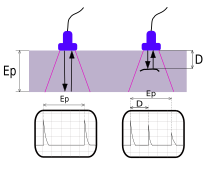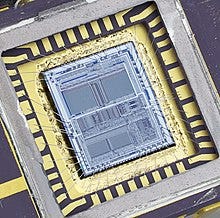What The Tech?! Ultrasounds
Ultrasound technology would provide cutting-edge imaging technology to the Medical and Aerospace fields.
What does a Bat, the Titanic, a ballistic missile submarine and a baby have in common? Read on to find out!
As we’ve explored some of the technology that helped shape the modern world, we’ve often seen stand-alone pieces of technology providing a single evolutionary change. Sometimes though, you’ll find certain inventions that changed many fields and proved to be a significant shift away from how we did things previously. Ultrasounds, or more specifically the field of sonography is one of these inventions and it’s the focus of today's What The Tech?!.
The Beginnings
The story starts with the bat in the 1700s, as this was the first time that scientists realised that they would use sound to navigate and hunt effectively. It was Lazzaro Spallanzani who was the first to study the theory of echolocation in bats. While this would be a far cry from the medical imaging devices that we see in today's world, it would prove the concept of using sound to map and identify objects of interest in an environment. Lazzaro Spallanzani would first prove the concept of sound based mapping and vision. Source: Wikipedia.
Lazzaro Spallanzani would first prove the concept of sound based mapping and vision. Source: Wikipedia.
Regardless of the theory being sound (get it?), the technology wasn’t there to leverage the concept effectively and it would take many more years before it would evolve into something more usable.
The first steps toward expanding the concept took place in a maritime environment. The sinking of the Titanic would bring the theory into mainstream concept and by the time of the Second World War, both submarines and surface vessels were using the concept in mainstream service. SOund NAvigation & Ranging (SONAR) equipment would evolve rapidly and by the time the Cold War was fully established, SONAR was an essential tool in the submarine service’s toolkit.
How Does It Work?
Effectively a radio transmitter, the Ultrasound unit will emit at a certain frequency, and the unit will use these emissions to carry out its intended purpose. Ultrasonic emissions can cover a large part of the spectrum depending on the design. Source: Wikipedia
Ultrasonic emissions can cover a large part of the spectrum depending on the design. Source: Wikipedia
Due to the fact that it’s essentially a transmitter, you’ll typically find that units will vary in frequency according to their intended role. Diagnostic imagery, for instance, is a long-wave MHZ emission that works great for looking into the body. Systems that work well for metallurgy and other specialised roles though, will often use even lower frequencies in the Khz range. These systems are able to correctly assess the condition of metal and perform other engineering tasks like cleaning and analysis.
So, for ultrasounds, there is no “one size fits all” concept that works, simply due to the sheer number of jobs an ultrasound machine is able to do. Ultrasonic imagery would play a significant role in detecting metal fatigue. Source: Wikipedia
Ultrasonic imagery would play a significant role in detecting metal fatigue. Source: Wikipedia
This makes it a particularly interesting field to study if you’re a science nerd as it will encompass several fundamental concepts covering physics and the radio spectrum. Ultrasounds during pregnancy are an everyday occurance now. Source: Wikipedia.
Ultrasounds during pregnancy are an everyday occurance now. Source: Wikipedia.
Role In Modern Industry
It’s fair to say that technology like this has had a near indescribable effect on how we’ve leveraged the technology for world-altering results.
Featal imagery, for instance, has allowed us to improve the mortality rates of pregnancy, leading to tangible effects for both mothers and babies.
Meanwhile, in aviation, ultrasonic imagery is used to predict and monitor failure rates in modern assets. This has led to improved manufacturing, better safety rates, and ongoing improvements in the way maintenance is carried out. Flying isn’t just safer because of improved engine technology, it’s safer because we’re able to detect and prevent metal fatigue far more easily than we could previously.
It’s also helped improve the reliability of modern automobiles as well. For instance, ultrasonic cleaning of fuel injectors helps to prevent carbon build-up, leading to more fuel-efficient and eco-friendly engines. Sonar, which helped the modern submarine would be a key part of the cold-war era submarine. This is the Virginia-Class boat, USS New Hampshire. Source: Wikipedia
Sonar, which helped the modern submarine would be a key part of the cold-war era submarine. This is the Virginia-Class boat, USS New Hampshire. Source: Wikipedia
We also see modern SONAR technology as a standard fit for modern submarines of all different types. These systems, which come in passive(non-emitting) and active (emitting) designs played a significant role in enabling the design of nuclear-powered, ballistic missile submarines. This would enable the concept of Mutually Assured Destruction, meaning that open war between nuclear powers would become less likely due to nuclear retaliation.
Into the Future
While sonography would help bring other industries into the modern world, the reality was that the field would also provide plenty of new industrial concepts as well. For instance, sonography would be used to help the body's tissue recover after surgical procedures, being used to break down and treat the presence of new scar tissues.
We’d also see more focus on the usage of sound as an industrial tool, as sonography would be used to weld together modern plastic materials. The concept, which focused on using sound to heat plastic particles would provide new ways to repair, modify and overhaul modern plastic components, helping to reduce waste. Ultrasonic bonding would also be adopted by the electronics industry. Source: Wikipedia.
Ultrasonic bonding would also be adopted by the electronics industry. Source: Wikipedia.
As the concept would continue to grow and undergo further refinement we’d also see significant improvement in image quality or resolution. In today’s world for instance, if you’re a new parent, evolutions in sonography mean that you’re able to get a multidimensional scan of your baby that in some instances even includes significant facial clarity.
It’s reasonable to assume that as the technology continues to evolve, we’ll also see constant improvement in this resolution due to the improvements that come with new technologies.
The humble sound wave had a far greater impact on the world than most people realise.
What The Tech is our recurring, twice-monthly piece that looks at the technology that was essential in shaping our modern world.
If you found this article insightful, informative, or entertaining, we kindly encourage you to show your support. Clapping for this article not only lets the author know that their work is appreciated but also helps boost its visibility to others who might benefit from it.
🌟 Enjoyed this article? Join the community! 🌟
📢 Join our OSINT Telegram channel for exclusive updates or
📢 Follow our crypto Telegram for the latest giveaways
🐦 Follow us on Twitter and
🟦 We’re now on Bluesky!
🔗 Articles we think you’ll like:
- What The Tech?! Rocket Engines
- OSINT Investigators Guide to Self Care & Resilience
✉️ Want more content like this? Sign up for email updates



































































